Page Summary
-
Earth Engine Apps are dynamic, shareable user interfaces for Earth Engine analyses accessible via a unique URL without requiring an Earth Engine account.
-
Apps can be restricted to members of a Google Group or made publicly accessible, viewable by anyone without signing in.
-
To build an App, you can use most Code Editor functions along with the User Interface API, but any image or table assets used must be shared publicly.
-
Apps are published from the Code Editor using the App Management panel, where you configure editor access, name, Cloud Project, source code location, and access restrictions.
-
Project-owned Apps, published under a Cloud Project, enable collaboration as anyone with the Earth Engine Apps Publisher IAM role can edit and delete them.
Introduction
Earth Engine Apps are dynamic, shareable user interfaces for Earth Engine analyses. With Apps, experts can use simple UI elements to leverage Earth Engine's data catalog and analytical power, for experts and non-experts alike to use.
Apps published from Earth Engine are accessible from the application-specific URL generated at time of publishing. No Earth Engine account is required to view or interact with a published App. Apps selected as featured by their creator are also available at a user-specific App Gallery (e.g., USERNAME.users.earthengine.app).
Build Your App
Earth Engine Apps can take advantage of most of the same functions used in the Code Editor, with a few exceptions. Additionally, we designed the User Interface API with Apps developers in mind. If you're new to the User Interface API, take a look at the UI API Overview.
Publishing Your App
To publish an App from the Code Editor, first load the script that you want to make into
an App, and then open the App Management panel, which you can access by clicking the
Apps button above the script section in the Code Editor.

Then click on the NEW APP button.

In the dialog, choose editor access, an App name, select a Google Cloud Project, and specify
the location of the App's source code. Restrict access to this App to a particular Google
Group or keep it publicly accessible using options under the Restriction tab. For publicly
accessible apps, you can also provide a custom preview image for the App as well as a
description in the Gallery tab. Click "Feature this app in your Apps Gallery" if you would
like this App to appear on your public gallery of apps available at
USERNAME.users.earthengine.app. Optionally include a custom logo in the
upper-left corner of the App by uploading an image of your choice from the Logo tab.

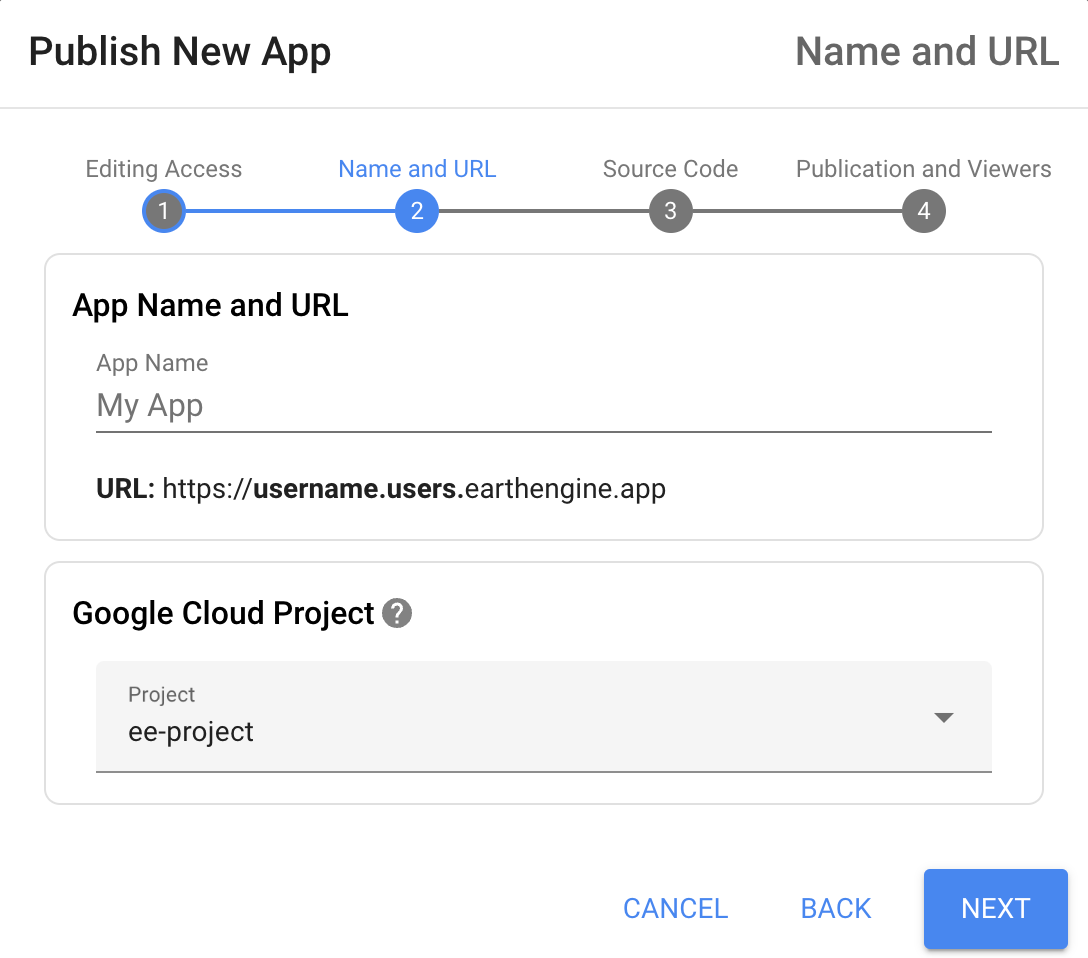
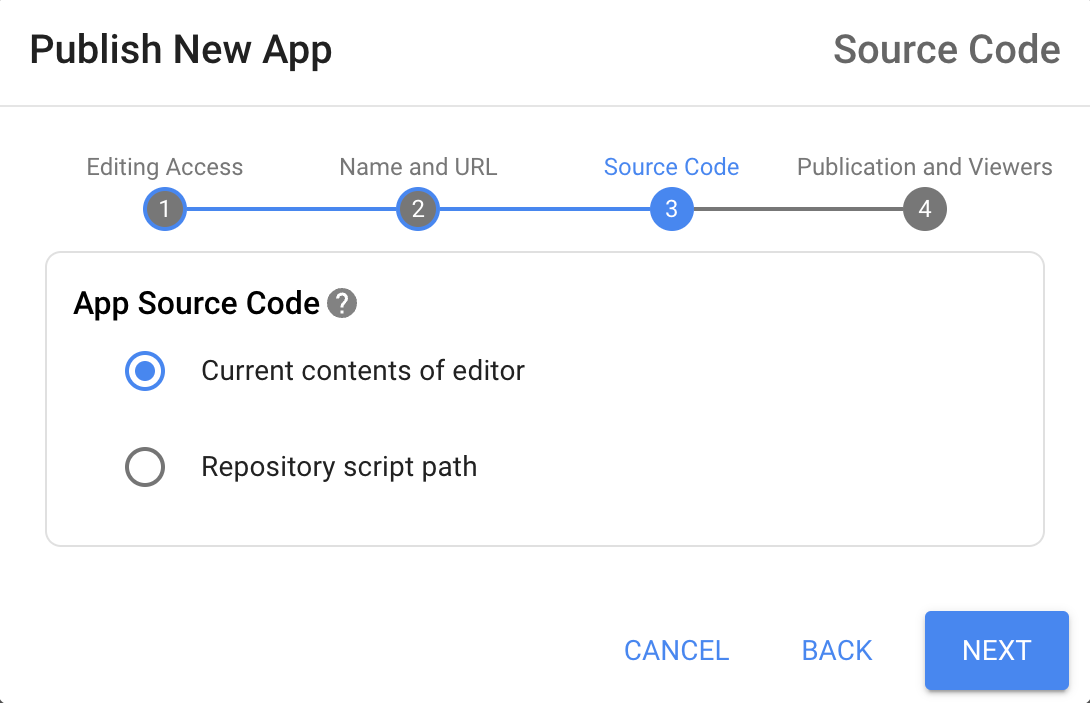

Managing Your Apps
To manage an App from the Code Editor, open the App Management panel by clicking the Apps button above the script section in the Code Editor. From here you can update your App's configuration or delete the app.
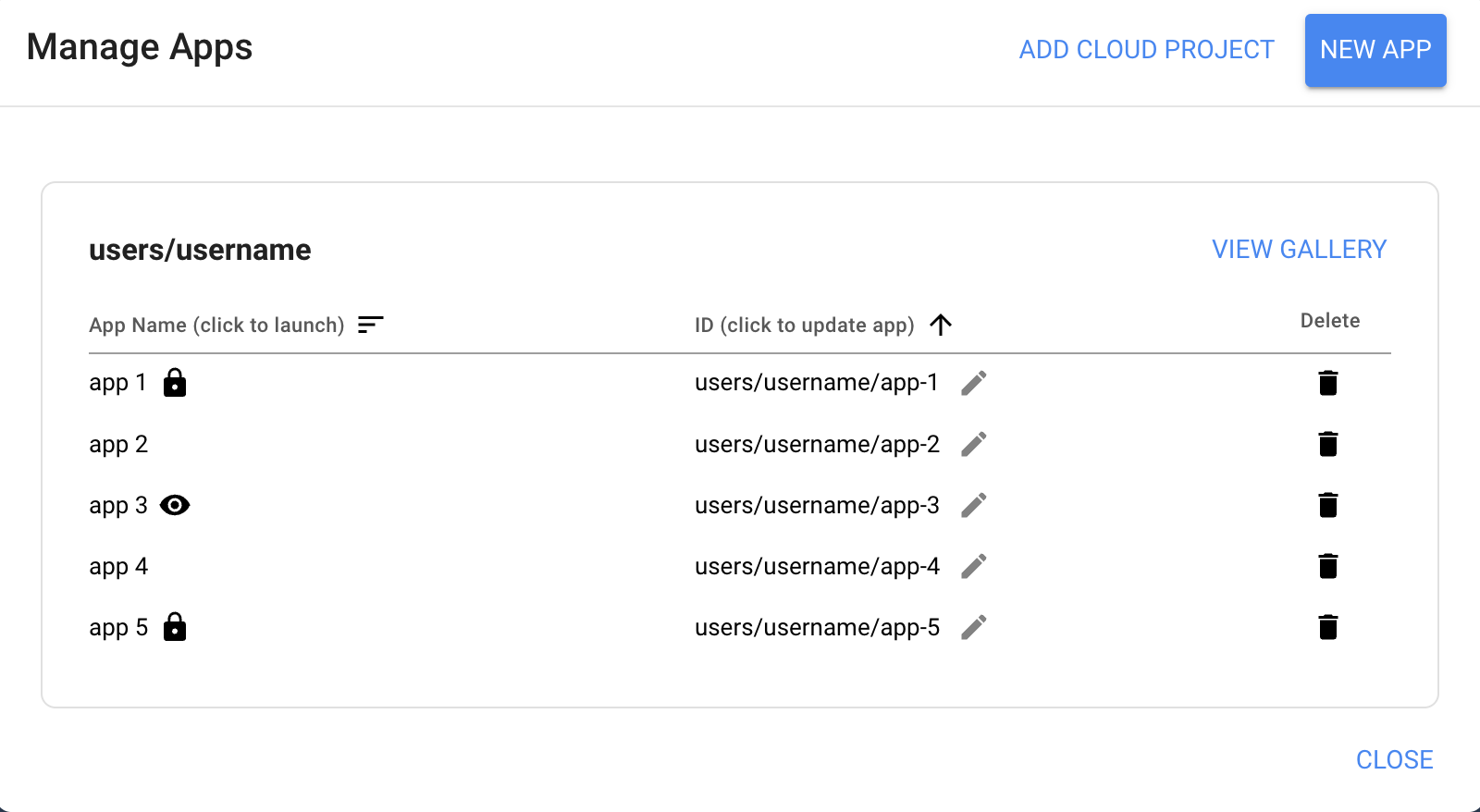
Collaborate with others on Project-owned Apps
By default, Apps that you publish under your username are only editable by you. Collaboration on Apps is possible with Project-owned Apps. Project-owned Apps are apps that are owned and published under a Cloud Project; anyone with the Earth Engine Apps Publisher IAM role can edit and delete apps published under the Cloud Project. Learn more about Earth Engine IAM Roles here.
To enable Project-owned Apps, choose the Cloud Project option on the
"Choose editing access" step and select the Cloud Project you would like to use, then finish
the App publishing flow as normal. The App will be published to the domain
PROJECT-ID.projects.earthengine.app and will be editable by anyone who has the
Earth Engine Apps Publisher IAM role on the Cloud Project.
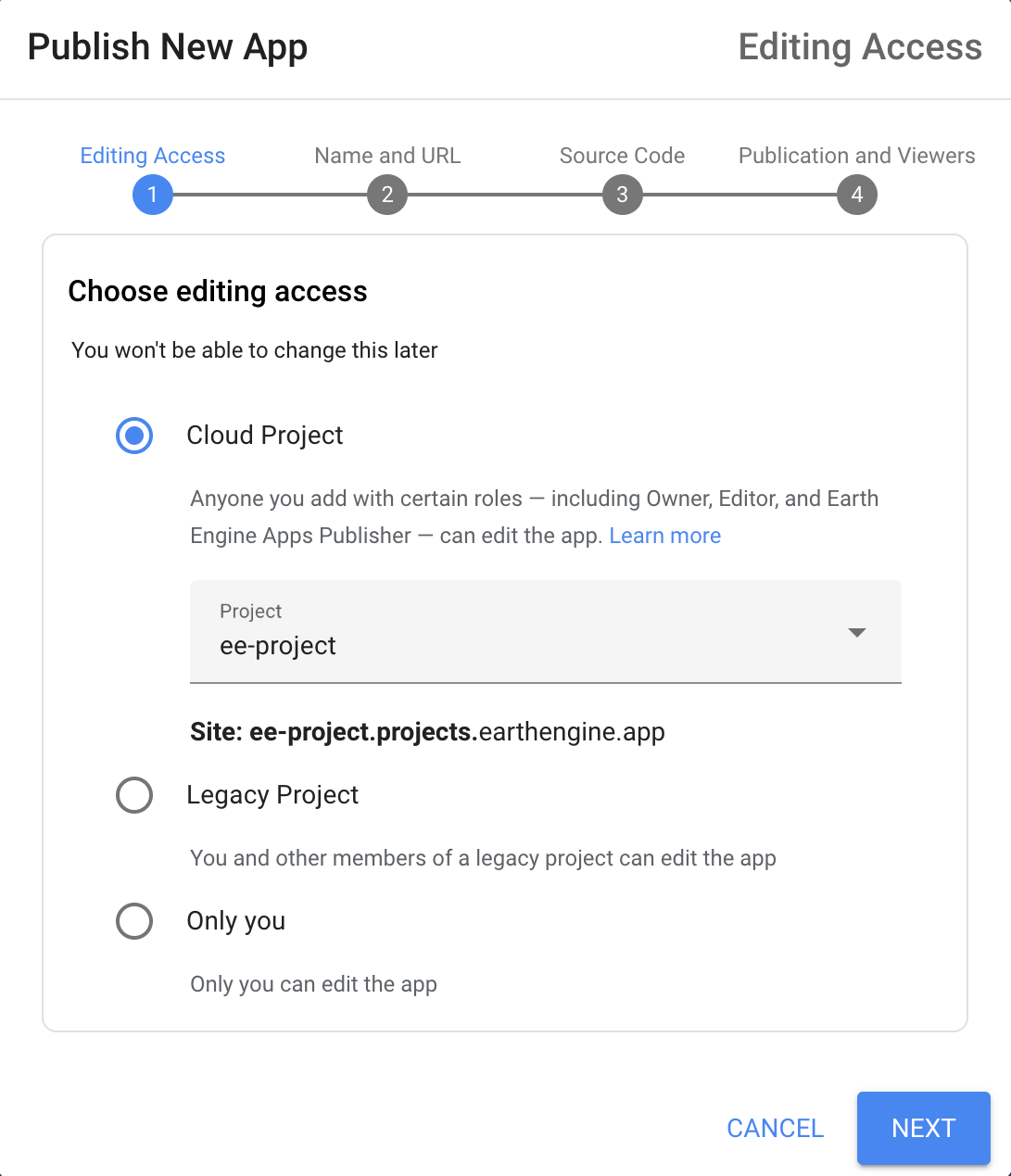
To view Apps for a Cloud Project, press the ADD CLOUD PROJECT button and select the Cloud Project.

To share the Cloud Project with others, press the SHARE PROJECT button. This will take you to the Cloud Console IAM page for the project where you can grant collaborators the Earth Engine Apps Publisher IAM role.
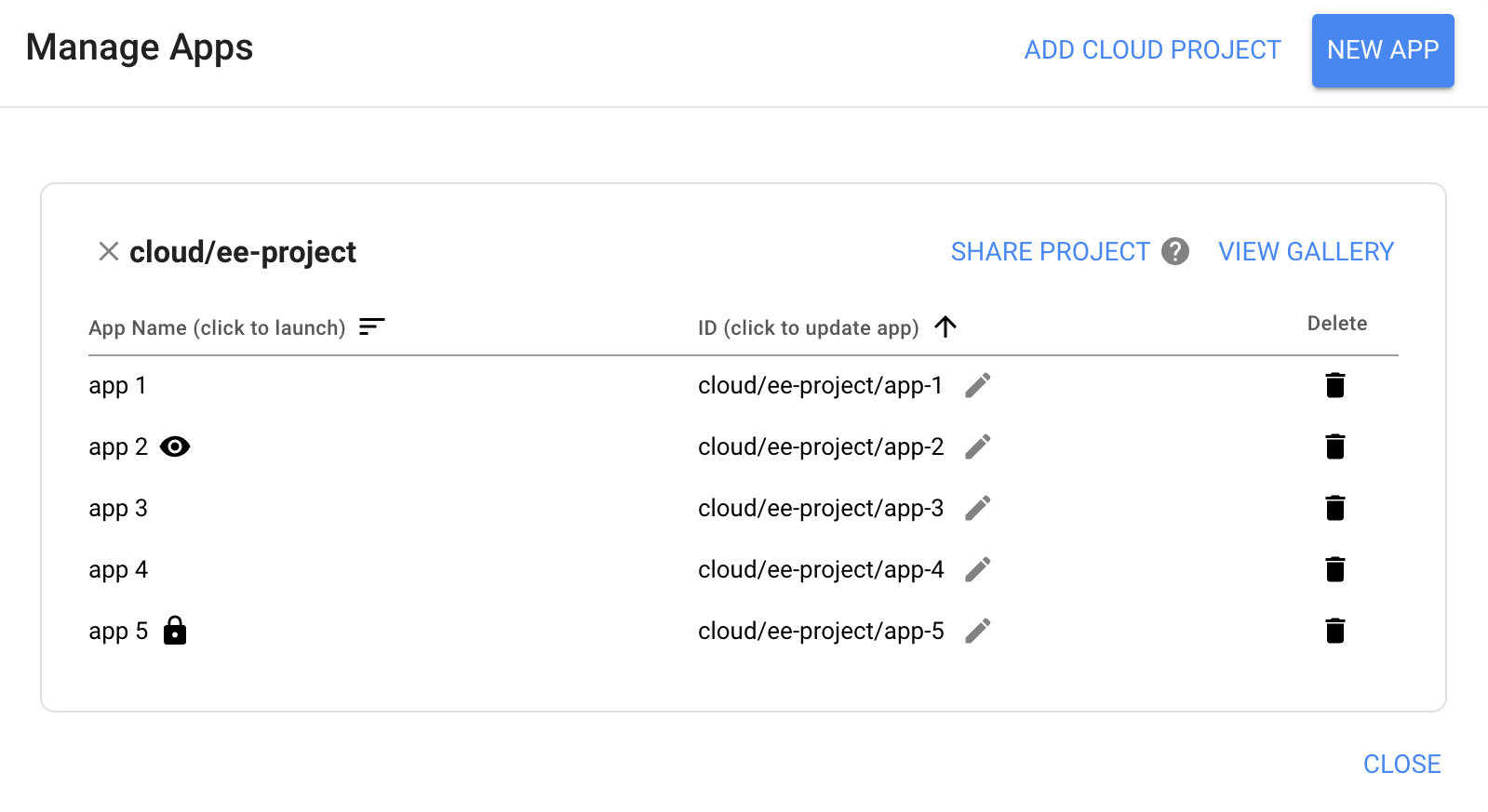
FAQ
- How do I remove an App from my Apps Gallery?
- The "Feature this App" checkbox on the App configuration page controls whether or not an App appears on the Featured Apps page. Apps with restricted access cannot be featured.
- Is my Earth Engine code visible?
- Yes, to anyone who can access the App. Although it's not clearly visible when your app is published, it's fairly easy for someone to view the JavaScript for your App by watching the network traffic to their web browser. In Chrome, for example, the JavaScript will be visible by looking at the Network panel of the Developer Tools.
- What are some possible causes of the "There was an error loading some parts of the map" error for a published App?
- Ensure all image or table assets used in your App are shared publicly or with the App. In the asset share dialog, select the "Anyone can read" option or choose the App name from the drop-down list. For apps restricted to a Google Group, sharing an asset with that Google Group will not make it viewable by the App; the assets should be shared with the App or publicly, instead.
- Why do I see an "app is not ready yet" page?
- After an App is created, it may take some time for information to propagate through the system. This is typically resolved within a few minutes. If the error persists, please reach out for help.
- Why are my drawn geometries shown in my App?
- This makes it easy to show reference geometries in your App, and allows you to create Apps where users can edit the geometries. If you don't want particular geometries to be shown or edited, you can hide or lock individual geometry layers to prevent users from seeing or editing them before publishing your App. See the geometry tools documentation to learn more.
- What is App quota?
- To prevent errant or resource-intensive scripts from negatively impacting the availability of the service, Earth Engine has App usage quotas on concurrent queries. This quota operates similarly to Earth Engine's per-user quota, except that the quota is tied to a the App, rather than a specific user.
- Does each App I make have its own quota?
- Yes, separate quota is associated with each App. For older apps created with an API Key, quota is tied to the Cloud Project from which you generate an App's API key. If you generate multiple API keys from the same Cloud Project, they will all share the same usage quota.
- Why is a Cloud billing account required? Will I be charged for my apps?
- We use Google Cloud Platform for a variety of behind-the-scenes tasks. You will not be charged for creating an Earth Engine App. However, Google Cloud Storage is not free, so if you choose to export the results of your analyses to Google Cloud Storage, there may be an associated fee.
- How can I understand my apps usage and quota better?
-
If the quota is exceeded, Earth Engine may return
HTTP 429: Too Many Requestserrors. Generally, these errors are handled by the Earth Engine client library, which wraps requests in exponential backoff, retrying the query until it succeeds. The Earth Engine client library will retry the request five times.If your app becomes so popular that many users get quota exceeded errors, users will see a warning message, and Earth Engine may have to (temporarily) restrict access to the app.
To help avoid receiving 429 errors, you may want to enable caching for your application, such as by storing cacheable aggregate statistics as Earth Engine table assets, rather than computing them on the fly.